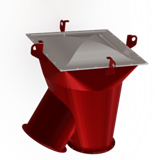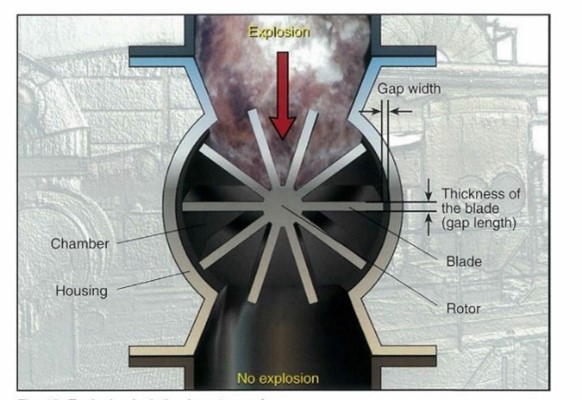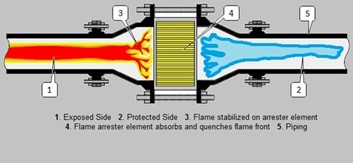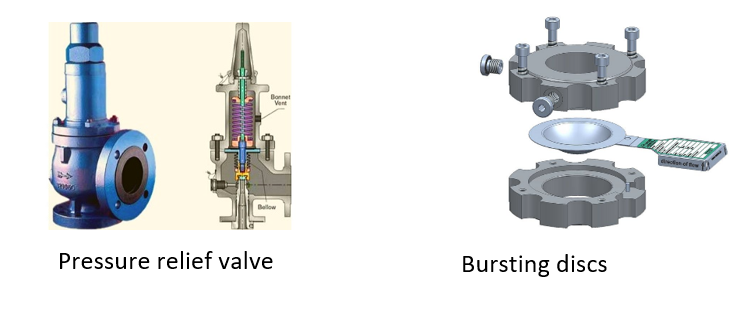Gary Horgan (CMSE Consultancy Manager at the Chris Mee Group) and his team are outlining the path for companies to ensure they are compliant with Part 8 “Explosive Atmospheres at Places of Work” of the Safety, Health & Welfare at Work (General Application) Regulations 2007 in a series of focussed blogs.
This is blog number 12 in the series, written by Denis Mulcahy which deals with engineering control measures to prevent and mitigate explosions
- Blog 1, Explosion Accidents 2020
- Blog 2, Preparing for an Explosion Protection Document
- Blog 3, Summary of Legal Requirements
- Blog 4, What Are Explosions?
- Blog 5, Characteristics of Flammable Liquids, Gases and Vapours
- Blog 6, Characteristics of Combustible Dusts and Powders
- Blog 7, Hazardous Area Classification – Dusts
- Blog 8, Hazardous Area Classification – Liquids, Gases and Vapours
- Blog 9, Static Electricity as an Ignition Source
- Blog 10, Non Electrical Ignition Sources
- Blog 11, Equipment selection for potentially Explosive Environments
- Blog, 12 Engineering Control Measures to prevent and mitigate explosions
Engineering Control Measures
When considering the controls to be applied to prevent and mitigate explosions, we can divide them into technical and organizational controls. In this blog we look at technical controls.
Technical controls come under two main headings. These being active and passive control and mitigation systems. Passive control and mitigation systems are generally preferred.
There are a number of schools of thought on how to differentiate between active and passive systems. However, one generally accepted approach is based on whether or not the system requires energy to operate.
Examples of some of passive systems would be to plan the layout of an installation to ensure there is sufficient separation distance between items of plant or equipment. Similarly, installing bunded areas to control spills or the use of passive fire protection in the form of fire doors / firestopping and fire protection for structural members.
Examples of active systems would be emergency power back-up systems, emergency shutdown systems and active fire protection systems such as water sprinkler / spray systems which are widely used for protection of process and storage vessels, loading installations and warehouses.
Choosing the most appropriate engineering controls is most important. An integral part of this process is selecting good high-integrity plant and equipment and ensuring that explosion safety is fully considered. This is best done at the design stage.
Considerations here may include explosion resistant construction. This may require a vessel to be strong enough to survive maximum explosion pressure in an explosion event, which is generally expensive, or it may be designed for pressure shock resistance which would have a smaller initial cost but may require vessel replacement after an explosion event. Similarly, the use of high-integrity pipework and minimising non-welded joints to minimise releases are other practical examples.

Preventing the formation of an explosive atmosphere is consider as the most desirable of all the controls. This may be achieved by ensuring that the activities carried out do not create an explosible concentration both internally (within a vessel) and externally (around a vessel). One of the most cost effectiveness ways to ensure this is through the use of dilution ventilation. The dilution ventilation may be either by natural ventilation or forced (extract fan) ventilation systems.
However, depending on the process, it may not always possible to control the concentration. An alternative would be to ensure the oxygen concentration is reduced to a level to too low to support combustion. i.e. being below the minimum oxygen concentration (MOC) within a vessel. This can be achieved by adding an inert gas such as nitrogen to the process vessel to displace oxygen. (nitrogen purging). This system may be supplemented by the installation of a gas detection system e.g. fitting an oxygen monitoring system to the vessel as an additional safeguard.

There are numerous other engineering control measures that assist with explosion prevention and mitigation such as Supervisory Control and Data Acquisition (SCADA) Systems and instrumentation monitoring and control systems. These provide information on process variables and may be linked to alarms or automatic shutdown systems.

Mitigation measures may included fire detection systems which detect fire and activate an alarm and / or a sprinkler or deluge system. Explosion suppression systems which detect explosion using pressure sensors (e.g. 10ms/ 0.2 bar). They rapidly inject an extinguishing medium in to a vessel or enclosure (water, chemical powder, inert gas) and extinguish the flame before significant pressure develops

Explosion venting protects equipment or buildings against excessive internal, explosion-incurred pressures, by means of pressure relief. The explosion vent is designed as weak panel opens at low pressure and vents combustion products. Thus, will relieve the pressure when the opening (or activation) pressure has been exceeded. The combustion products need to vent to a safe location outdoors. The addition of a quench box (Q Box), which is a similar device to a flame arrestor, is required for venting indoors.

Chemical suppression barriers use rapid discharge of a chemical explosion suppressant to a duct, pipework or vessel to prevent the flame propagation to other areas. An explosion detector initiates the release of the extinguishing agent when it detects a deflagration pressure or a flame front.

Explosion isolation (slam shut) valves are designed to prevent a pressure wave created inside a vessel or pipework, due to an explosion, from traveling upstream towards to source of the flow. Thus protecting workers, equipment and the facility.

Explosion Diverters which are mechanical explosion isolation devices which protect ductwork and prevent propagation. When an explosion occurs it accelerates down the pipeline and enters the diverter U-bend. Rather than altering its natural flow and change direction, the explosion pressure hits a spring-loaded door in the U-bend which vents to a safe area. When the energy has dissipated, the door will reclose preventing oxygen from entering the pipeline.

Rotary valves handle and meter the flow of granular bulk or powders at a controlled feed rate. Material is fed into the valve via a hopper or pipework and passes in discrete packets through the valve rotor to the output side with minimal pressure loss. They work function as airlocks, explosion/flame barriers, and process isolators, among other tasks.

Flame arresters which function by forcing a flame front through channels which are too narrow to permit the combustion to continue thus extinguishing the flame. These passages can be regular, like wire mesh or a metal plate with punched holes, or irregular, such as those in random packing.

Other simple device include, pressure relief valves and bursting discs which protect vessels and pipework from over pressure.

Last but not least is the selection of electrical equipment suitable for hazardous areas.
The specification is based on the zone designation, the properties of the material being processed and the type of application.

The afore mentioned are just a few examples of the many and varied engineering control measures for consideration when deciding how best to control flammable / explosive atmospheres in the workplace.
Sign up here to receive the next article in this series directly to your inbox before it goes live to the public
CMSE Consultancy provide professional Occupational, Process, Explosion & Fire Safety Services.
If you require further information or assistance please contact us via email at info@cmse.ie, by phone at 021 497 8100 or start an instant chat with us via the chat box in the bottom right-hand corner of your screen.
